|
FAQs about Tube Snail
Identification
Related Articles: Tube Snails, Mostly Family Vermetidae,
Gastropods, Mollusks, Sea Slugs, Abalone,
Related FAQs: Tube Snails, Marine Snails 1, Marine Snails 2, Marine Snails 3, Marine Snails 4, Marine Snails 5, Snail ID 1, Snail ID 2, Snail Behavior, Snail Selection, Snail Compatibility, Snail Systems, Snail Feeding, Snail Disease, Snail Reproduction, Mollusks, Sea Slugs, Abalone,
|
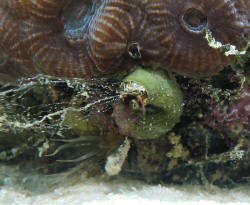
|
|
Critter ID 10/25/27
Hi there, I've got a funny little dude on one of my corals. I've asked every
reefing group I can find and no one has an idea. It started off between these
two heads of hammer coral and looked like a Chiton at first--it's a series of
armored plates. Then it sort of curved as you can see here in the photo and it's
growing fast. There are three of them now.
It is very, very hard--harder than the coral stalk and absolutely nothing budges
it, even trying to slide a razor blade under the edge hasn't been successful.
The picture below shows it just opened its 'mouth' end which is usually shut
tight. Any ideas what it could be? I'd hate to kill it if it's a reef safe
critter. Thank you!!!
<Mmm; can't quite make out in your pix, but would have guessed at first glance
that these were Chitons as you mention, and with the clue that they can't be
removed with a razor blade either limpets of some sort or, my final guess (for
now) that these are a species of calcareous tube-building worm or snail. I would
leave them here.
Thank you for sharing. Bob Fenner>
|

 |
|
Mystery hitchhikers on my frogspawn
2/10/17
Hello WWM crew!
<Kevin>
I was referred here from Bayou Reef keepers by Jordan Stari.
<Ahh! Hi to Jordan. Hope to catch up with him at this year's MACNA there>
He recommended that I post this query specifically directed toward Lynn Z
since she’s the invert expert. I have a mystery beastie on the base of two
of my branching frogspawn heads. When they first showed up, they were so
small I could barely tell they were something other than part of the coral.
Then I started noticing they had kind of a corkscrew antennae or
some other protrusion. I thought they might be some kind of
Nudibranch, but even with a magnifying glass, it was difficult to pick out
any distinguishing characteristics. I searched every site and message board
I could find to no avail. They are right at the boundary between the soft
tissue and the skeleton of each head and seem to retract into the soft
tissue if I shine a light on them for more than a few seconds. When I got
home from work today, one of them had come out far enough that it was ~1/2 –
3/4” long. I took some pictures, but only one of them is small enough in
file size to comply with WWM picture requirements and it is hard to see
anything on that one. I have attached it as a first look. If it’s okay, I
would like to post the best quality picture that shows it pretty well.
Please let me know if that is ok.
<Yes; though; I don't see what you're referring to. Lynn?>
I have had these corals for about two months and they have grown probably
2-3 times the size they were when I got
them in that time. Two of the heads have begun to split. Until about 4 days
ago, all seemed to be well. All of the corals in the tank have been given a
10 minute CoralRx Pro dip before being placed in the tank. I’m thinking that
since they emerged from within the soft tissue, maybe they were there from
the beginning and survived the dip.
In the pic, the dark vertical shape on the left is the branch of the
skeleton. The offending beastie is the whitish thing running parallel to the
branch (it is roughly ½-3/4” in length). As I said, I have better pics, but
did not want to run afoul of the posting rules.
<Do post elsewhere on the Net and send along links please>
Please let me know if you know what this is, whether I should worry about
it, and how I can get rid of it if necessary.
<Like grading school papers, "When in doubt, count it out", I'd vacuum,
remove this>
Thanks in advance for the help!
Kevin Drane
<Have sent on to LynnZ for her input. Bob Fenner>
|
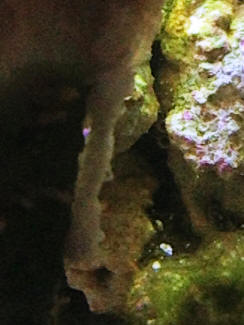
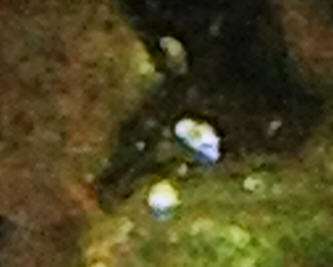 crop...
crop...
|
Re: Mystery hitchhikers on my frogspawn - 2/11/2017
Thanks for the quick response. I have a couple of pics posted on the Bayou
Reefkeeping forum. Here's a link:
Euphyllia eating Nudis?
<http://www.bayoureefkeeping.com/forums/topic/16109-euphyllia-eating-nudis/#comment-191958>
<Mmm; the little white bits right? I don't see rhinophores, gills on these...
Look more like Scutus... a snail on what little I make out... white shells
(could be overgrown), and black feet... No way for you to remove, shoot and send
a better close up pic?>
It seems to be hiding within the soft tissue of the coral because there are
times when you can't see it at all and then it just appears. Thanks again for
the help!
<The better pic please. Bob Fenner>
|
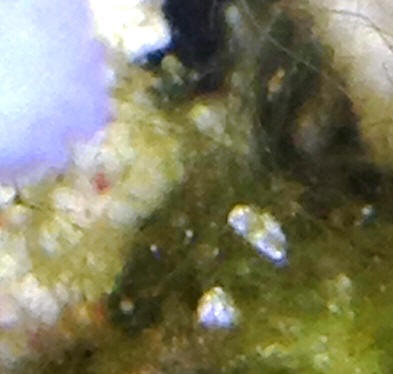 |
|
Re: Mystery hitchhikers on my frogspawn - 2/11/2017
Actually, the long white thing that is extending down from the base of the soft
tissue is one organism. The white bits are part of it.
<Don't see it mate>
There is no shell and it's all white. While it was extended out like that last
night, I tried to suck it out with a turkey baster and it held fast. I then
tried grab it with some tweezers and it still wouldn't come loose. It ended up
breaking in two. The part that was still attached retracted up into the coral's
soft tissue and I haven't seen it since. The part that broke off
kind of fell apart and the pieces were very small helical bits maybe 2-3 mm
long. My fire fish ate ended up eating the pieces. Now I'm worried that it is
going to die inside the soft tissue and as it rots will poison the coral. I'm
debating whether I want to break the heads free from the rock and dipping them
with Bayer.
<Have you considered fragging this colony? I might. B>
Re: Mystery hitchhikers on my frogspawn - 2/11/2017
Thanks for the quick response.
<<Hi Kevin and Bob. Sorry I’m a late arrival on this topic!>>
I have a couple of pics posted on the Bayou Reefkeeping forum. Here's a link:
Euphyllia eating Nudis?
http://www.bayoureefkeeping.com/forums/topic/16109-euphyllia-eating-nudis/#comment-191958
<Mmm; the little white bits right? I don't see rhinophores, gills on these...
Look more like Scutus... a snail on what little I make out...white shells (could
be overgrown), and black feet... No way for you to remove, shoot and send a
better close up pic?>
<<Unfortunately, I can’t see enough detail in the photos to determine exactly
what the subject is either. Offhand, it looks like a typical looping mass of
Cerith snail eggs - I’ve seen these before on Euphyllids. Please see the
following link for an example (bear in mind that these looping masses can be
variably arranged): http://www.nano-reef.com/topic/270550-whats-on-my-frogspawn/
. Do you have any of these snails in your system? If so, and this is an egg
mass, the multitude of loops should start breaking up and detaching within a few
days.>>
It seems to be hiding within the soft tissue of the coral because there are
times when you can't see it at all and then it just appears.
<<If this is an egg mass, perhaps it’s acting as an irritant? Honestly, I’m not
a coral expert so I’m not sure if it’s possible for the soft tissue on a
euphyllid’s stalk to react by trying to alternately envelop then repel an
irritant.>>
Thanks again for the help!
<The better pic please. Bob Fenner>
<<You’re very welcome. I just wish I could have given you a concrete answer.
Ditto what Bob said regarding a photo (if possible!). Take care, Lynn Zurik>>
<Thank you Lynn. B>
Re: Mystery hitchhikers on my frogspawn: Mesenterial Filaments -
2/11/2017
<Greetings, Kevin>
I do not have any Cerith snails
<There goes that theory! On the plus-side, I believe I have an answer for you.>
and I've never seen snail eggs move around like this.
<No, any movement would have to have been caused by something else: water
current, hatching individuals, instability/movement of whatever the mass was
deposited upon, or perhaps a critter of some sort wriggling about inside the
mass.>
Unfortunately, I can't get another picture because after I tried to pull
it off, it retracted back up into the soft tissue of the coral.
<Yep, this is normal (see below).>
There is no question in my mind that it is some kind of separate organism. I
have posted another picture to the forum- this time with annotation.
<Yes, I see – thanks. After thinking about this a bit more this morning, I
started wondering if what we were seeing was simply part of the coral itself,
and that was the ticket. All those loopy structures (that look like guts) did
indeed come from inside the coral. They’re mesenterial filaments
that, thanks to stinging cells/nematocysts, are used to capture/digest, as well
as fight off any threat/intrusion into a coral’s “space”. It could be that the
coral detected a threat (physical or chemical), and deployed the filaments. I
see a small collection of vermetid gastropods to the left of the filaments that
may be at least part of the issue. Vermetids send out sticky strands to catch
food particles that drift by. Those strands could be contacting the coral’s soft
tissue and irritating it. I ran across a photo at WWM that looks very similar:
http://www.wetwebmedia.com/carydisf7.htm . Please see the query at
the bottom of the page titled “Worm infestation… no -12/28/2007”, as well as a
WWM search for mesenterial filaments, Vermetids.>
I appreciate the time you have spent trying to help me.
<No problem, I hope this helps. By the way, if you decide to get rid of the
Vermetids, you can do so my either breaking them off with tweezers at the base
(do not use bare hands – the tubes are brittle and very sharp!), or seal the
tube openings with some gel-type Cyano glue.>
Hopefully the new picture will help you see it better.
<I think we’re good to go! Take care, Lynn Zurik>
Thank you Lynn. B <Always a pleasure, Bob!>
Follow-up Re: Mystery hitchhikers on my frogspawn: Mesenterial Filaments -
2/11/2017
Awesome! Thanks for the diagnosis.
<You are most welcome.>
Jordan was right that you know your stuff.
<Well, we all learned something this time! All I knew was that things weren’t
adding up, critter-wise, so I followed a hunch and it paid off.>
You just saved the coral from the trauma of being broken off the rock and dipped
again.
<Good>
I just knew it was some kind of parasite.
<I can certainly understand why.>
Unfortunately, in my haste to keep a parasite from harming my coral, I tore some
of its mesentery trying to remove it. Hopefully it recovers!
<I would think so.>
It all makes perfect sense now that I put all the pieces together. They had
(very small) Vermetids on them when I bought them as frags. The coral and the
Vermetids have both grown considerably since I got them.
<Yay, regarding the coral! As for the Vermetids, they thrive/multiply in high
nutrient conditions so do keep an eye on this. Same goes for what appears to be
some Spionid or Chaetopterid worms to the right of the mesenterial filaments. In
silhouette, you can see a number of paired feeding tentacles (“palps”). Although
not visible in the photo, these palps extend from hardened mucus tubes covered
with sand grains, bits of substrate, and/or shell. These worms are typically
harmless/beneficial particulate feeders/detritivores but when numerous can
irritate corals, particularly Zoanthids.>
In the last couple weeks, the coral has not been extending as much as it had
been. Now I realize it was due to the Vermetids growing as much as they have. I
will try scraping them off now that I know they are causing irritation.
<Good idea. Just be careful. You do not want to get a nasty infection after
cutting yourself on those sharp little shells!>
Thanks again!
<It was a pleasure! Take care, Lynn Zurik>
|
|
|
Worm Identification: Vermetid Gastropod - 11/29/12
This worm has hitchhiked in, I'm trying to make sure that he isn't
posing a threat to any beneficial animals.
<Although it does look worm-like, it’s actually a Vermetid Gastropod.
These are sessile snails that can, on occasion, irritate nearby corals
just through constant contact with their feeding web/strand but are
otherwise harmless. Please see the FAQ’s at the following link for
more photos and information:
http://www.wetwebmedia.com/MolluscPIX/Gastropods/Prosobranch%20PIX/Vermetids/tubesnailidf.htm?h=
Take care, Lynn Z>
|
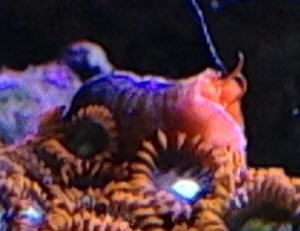 |
|
Is this a friend or foe in my aquarium?
2/9/12
Hi
<Bob>
I stumbled upon your website a few days ago while trying to
identify some things that are going on in my wife Teal's
aquarium. I bought this established aquarium a few months ago and
it is our first large aquarium.
She has also maintained an 8 gallon biocube for about a year with
good luck.
<A feat!>
This tank was purchased with lots of Liverock. Critters that came
with it were a tomato clown, a Naso tang,
<I hope this tank is large... at least a six foot length. See
WWM re Naso lituratus care>
and a percula clownfish. We also got a few anemones in the tank
as well as some large snails and feather duster worms. When we
were tearing the tank down before moving it, the guy mentioned
that they found worms in the tanks, possible bristle worms.
<No big deal generally>
Today my wife said that she removed a few of the worms from the
tank. When we set up the tank in our house we put in 80 lbs of
aragonite sand.
There are a couple spots like what is shown in the picture in the
tank and it is a concern of hers. There appear to be a few snail
like creatures living in this stalagmite looking tube.
<Indeed they are. Please see here:
http://www.wetwebmedia.com/MolluscPIX/Gastropods/Prosobranch%20PIX/Vermetids/tubesnailidf.htm>
At times we see a web like material
stringing from them and it appears that they are catching or
snagging floating debris and them reeling it back in for them to
feed on.
<Well put>
Can you identify what is in this picture and can/should I leave
them alone?
<Are tube snails of some sort and I would keep them>
Are they harmful to her tank? If I need to remove them, what is
the best way?
<Not harmful. IF you wanted to remove, best to use a pliers or
such, and break off the base of whatever they're attached
to>
I love your site (from what I've seen) and will be back to do
more identification on things in her tank.
Thanks very much!
Bob and Teal
<Welcome. Bob Fenner>
|
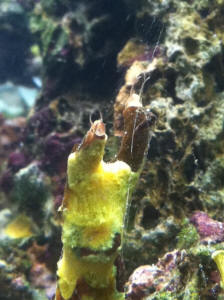 |
|
Tube Worm or Feather Duster: Neither! Vermetid
Gastropod -- 11/15/11
Hi there,
<Hey there Fanny, Lynn here this evening.>
I have a 50 gallon marine tank that is over a year established
and doing fairly well except for the loss of coral as of late. I
just noticed this unidentified 'tube worm/snail' I've
attached a picture. It is about the size of a dime (judging by
the pink coiled tube) and a snail like head is popping
out of the right end, the shape of which is spade like
with two antennae. It does not seem to leave the tube but it
sends out a mucus to catch particles and then it pulls it back in
to eat.
<Great observations!>
After searching the internet and this site I cannot identify this
creature, can you help? I suspect it to be a barnacle or an ugly
feather duster, but neither of those seem to have only two
antennae...
<It's actually a Vermetid Gastropod, a variety of sessile
snail that casts out a mucus net/web then reels it back in to
feed. These snails are mostly harmless and beneficial, but their
webs can on occasion irritate nearby corals just through constant
contact. For more information, please see the related FAQ's
at the following link:
http://www.wetwebmedia.com/MolluscPIX/Gastropods/Prosobranch%20PIX/Vermetids/tubesnailidf.htm
>
Thank you for the help!
<You're very welcome!>
I refer to this site often and it has always helped so much.
<Thank you, that's great to hear/read!>
Fanny Fishtank
<Take care, Lynn Z>
Re: Tube Worm or Feather Duster: Neither! Vermetid Gastropod --
11/16/11
<Hello there, Fanny>
Oh thank you again!
<You're very welcome! Take care, Lynn Z>
|
|
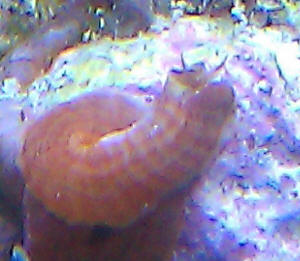
|
|
Mystery Mollusk 1/17/11
Would love it if anyone can point me in the right direction on an
ID for a hitchhiker that came in with one of my Zoa colonies. I
think it's a mollusk...I've had trouble putting together
a good enough description of
this thing to generate a proper search string. I've scoured
photo ID pages of mollusks and gastropods, but I don't know
if I'm even on the right trail.
<Mmm, I think I see what you're referring to... have
cropped the middle image you sent along... see the Daily FAQs
re... This is a Vermetid Snail:
http://wetwebmedia.com/MolluscPIX/Gastropods/Prosobranch%20PIX/Vermetids/tubesnailf.htm
This little guy is only about 2-3mm in diameter. He is embedded
in a rock that houses a Zoa colony, and seems to be permanently
attached. Hasn't changed location since I got the rock/colony
about 5 months ago. He has a radial disc-shaped top shell that is
reddish-brown and looks like an operculum of some
kind with a hole or depression in the center, and he can withdraw
and seal himself shut with it.
<Good clues, description>
When he pops open, there's a soft body that looks sort of
like a tiny snail, and I count 4 tentacles, 2 very short and 2
longer, one of the longer ones about 3 times as long as the
other, stretching to about 5 mm.
His behavior is the most peculiar thing about him, and what made
me notice him to begin with. He seems to feed by spooling out a
long strand of mucus as a fishing line, and then slowly reeling
it back in a mm or so at a time.
<Yes>
At first I thought it was a secretion from the Zoas, but it is
just a single thread that traces back to this guy, and he does
consume it as he reels it in. In fact, sometimes he
'catches' one of the Zoa polyps and bends it back up
towards him, but he doesn't seem to do any damage, it just
gets released once he pulls the thread back in.
<Not problematical>
The hole in the shell had me thinking keyhole limpet from some
pics I saw, but it sounds like those are bigger and more mobile
and snail-like. I then found a description of Limacina helicina
that described what sounded like a similar mucus-fishing
behavior, and pics look a little similar (though transparent),
but
that sounds like it's a free-floating snail or jellyfish of
some sort (http://jellieszone.com/limacina.htm). I also wondered
if it could be some kind of barnacle, but haven't seen any
mention of these in my searches.
It's proven difficult to get a clear photo of this guy due to
his size, but I've attached a few small ones that are the
best I've been able to do. Any help you can provide is
greatly appreciated!
Thanks,
-Tommy
San Francisco
<Do see my pix on the citation and the linked files (above) re
this family. Bob Fenner>
|
|
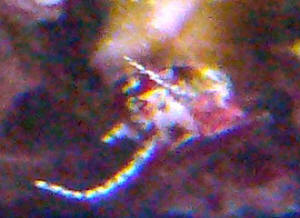
|
|
Re: Mystery Mollusk
That's the critter! Thanks very much, good to know he's
not a threat.
More reading to do now...
-T
<Ahh! B>
|
|
Brown Round Tube on Rock Casting Web Around Zoas,
Soft Coral: Vermetid Gastropod Control -- 4/15/10
<Hello Selah, Lynn here today.>
First Timer
<Welcome to WWM!>
Another what is this?
<Fire away>
Brown round or doughnut shape tube (white opening at the end or
in the center) of circle. It is very small on rock, casting web
(not like pic of Spaghetti worm) around corals.
<It's a Vermetid Gastropod, a snail that crawls around as
a juvenile, but eventually attaches itself to a hard surface and
remains there for the rest of its life. They feed by means of
casting out, then reeling back in, a sticky mucous net that
catches particulate matter and plankton that drifts by in the
water column. Most of the time, these snails are
harmless/beneficial, or at least innocuous, in reef systems but
if they're close to a coral, they can act as an irritant. The
webs don't actually sting the coral, they just irritate it
through continual contact.>
I have been searching thru your website have not found the ID of
this creature.
<You're good to go now!>
The web is much finer than a Spaghetti worm, really like spider
web material.
<Yes it is. Spaghetti worm tentacles are hair-like, while
Vermetids' are web-like.>
The little Kenya tree and Zoas coral are closing.
<Yep, that's a typical reaction.>
I have wiped off the stuff but now since searching WWM again
there are more, so felt the need to ask.
<Do you mean there's more web appearing or that there are
more of the Vermetids appearing here and there on the rocks? If
it's more web, that's normal. These snails don't have
just one that they reuse, they create them as needed. If you mean
that you're seeing an increasing number of Vermetids, then
you may well have a growing nutrient problem. They tend to
multiply in high nutrient situations so take action if necessary.
Please see the following link for more information re: http://www.wetwebmedia.com/nutrientcontrol.htm
>
I sent a picture to Dr Foster and Smith and they can't
identify. Enclosed are 2 pictures one close up and the other have
3, the fine line is too small to photograph, can only see with
magnifying glass. I see a little critter in the white tube like
end and even have seen the very fine line come out of it as it
comes out. When I get close they see me and go back in. They are
attached to the rock so well it crushes them when I pull them
off.
<Be sure to avoid handling these with bare hands. The shells
are thin, brittle, and can slice your fingers/hand fairly easily
and lead to a nasty infection. It's a good idea to wear
gloves and/or use tweezers (or whatever works) when
handling/removing these organisms.>
I would not be concerned however the little bit of coral I have
are being affected.
<Yes, you'll need to eliminate the offending Vermetids.
There's a lot of information at WWM regarding this. If you
only have a few, or are only concerned about the ones near the
corals, I'd recommend manual removal (with care) or plugging
their tubes with something like a superglue gel. If you have a
lot of them, watch your nutrients. There are apparently some
predators that may eat these (some hermits, fishes and crabs),
but they may not be appropriate for your system. Please Google
WWM, using the term Vermetid + Control for more information:
http://www.wetwebmedia.com/Googlesearch.htm
More here: http://reefkeeping.com/issues/2005-01/rs/index.php
>
My system is a 55 gal, good water parameters, Nova extreme light,
good water movement.
1 clown, LTA, 2 Pajama Cardinals, Emerald crab, Hermits, 1 Conch,
2 Turbo snails. All the guys seem happy and healthy. This
website, Conscientious Marine Aquarist and The Reef Aquarium have
been invaluable since starting our new hobby. I live in a very
remote part of country and LFS have been a bit of a challenge as
I have received incorrect info from the surrounding ones.
<Unfortunately, that seems to happen everywhere.>
I took Bob's advice and have returned items that should not
have been sold.
<Excellent, he does know what he's talking/writing
about!><<Heeeee, only some, part of the time.
B>>
Thank you so much for your time
<You're very welcome. Good luck with the
Vermetids!>
Selah in the mountains
<Take care, Lynn Z, near the mountains>
|
 |
|
ID Please: Vermetid Gastropod -- 7/5/09
Good morning!
<Hello Lori, Lynn here today!>
Recently I have noticed this interesting bright orange organism
in my 30 gallon SW reef tank.
<Neat>
It is attached to the inside crevice of my live rock and has a
long tube coming out. I tried to research tube worms, corals and
even sponges, but have located nothing that totally describes
what I am seeing.
<It looks like a Vermetid Gastropod, a sessile, suspension
feeding snail of which there are many species. These are mostly
harmless/beneficial little hitchhikers, although occasionally
they can irritate corals -- especially in high concentrations.
Luckily that doesn't happen very often. For the most part,
they're simply another neat addition to the biodiversity of a
system.>
It seems to extend a sweeper tentacle most of the time, which I
believe is evident in the photo I am sending.
<Yep, it looks like the typical (sticky) mucus strands that
Vermetids use to catch food (planktonic/particulate matter). The
strands are released into the water column, left out for a bit
then reeled back in. Sometimes the strands spread out and appear
more web-like, other times they form what you see in your photos
-- a more cohesive unit comprised of many sticky filaments that
drifts about in the water. As for the color of the tube -- it
varies. I've seen anything ranging from white to dark
brown.>
Sorry for the hermit crab that's in the way.... he just would
not move for a better photo!
<Heee! There's always at least one 'camera hog' in
everyone's tank!>
Any insight on this very intriguing addition to my tank would be
welcomed.
<They are indeed an intriguing addition! For more information,
please see the following links:
http://reefkeeping.com/issues/2005-01/rs/index.php
Google 'Vermetid' at WWM for various faq's re:
http://www.wetwebmedia.com/Googlesearch.htm >
Thanks all!
<You're very welcome!>
Lori in Tampa
|
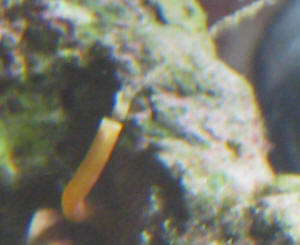 |
-invert ID-- possibly Vermetid snails-
11/27/08
Crew,
<Hello, first, I'm so sorry it has taken this long to get back
to you.
Sometimes some of our crew members move emails to their folders and
forget about them.>
I've recently developed some sharp spines about a quarter inch in
length growing all over my live rock. What is it?
<It's difficult to say without a photo, but they could be
Vermetid snails.
Please visit these links and see if you can find something that looks
like what you have growing on your rock:
http://www.wetwebmedia.com/MolluscPIX/Gastropods/Prosobranch%20PIX/Vermetids
/tubesnailidf.htm
http://www.wetwebmedia.com/MolluscPIX/Gastropods/Prosobranch%20PIX/Vermetids
/vermetidsnails.htm >
Is it harmful? If so, how do I control it? 140 gal salt under tank sump
set up about 1 year ago. Fish only right now with plans to do a
reef.
<If they are tube snails, they're probably not harmful... and
will likely start to die off eventually on their own.>
aqua c EV 120
1/4 HP chiller
40watt UV sterilizer
Red Sea Ozonizer (currently disconnected)
Twin 150 watt metal Halides w/ twin 65 watt actinic
Michael A. Grande
<Best,
Sara M.>
|
Hydroid, ID, control... 11/14/08 Hello all!
<Mariusz> I was hoping you could give me an ID (i.e..
scientific/common name) on this Hydroid. It was taken from:
http://www.wetwebmedia.com/hyzoanidfaq.htm (i have also attached
the same pic). I have a bunch of these in 120 tank with about
140lbs of live rock. <Mmmm... can't tell the species from
this small pic> I recently took all fish out of the tank to
let run fallow after a parasitic infest. Most corals have been
removed (for other reasons). All that is left are a few mushrooms
and leathers, peppermint shrimp, hermits. The tank has been
running fallow for 6 weeks now and I'm in no rush to put my
livestock back in. Also for 6 weeks I haven't put any food in
the tank either, it's just been running with Deltec skimmer
(which hasn't produced much as I have almost no livestock and
no feeding). So questions: 1) are these hydroids a danger to
fish? not sure how potent the sting is. <Could be... if
they're unaware, get too much exposure> 2) How can I rid
these with out manual removal as I've been trying for almost
a year. Not sure if these guys are worms of some sort and if
de-wormer will work, possibly Prazi or other. Is there any
biological alternative? Without proper ID its been difficult
moving forward towards a solution. Thanks <Can be very
difficult... frustrating up to the point, extreme, of making it
reasonable to bleach/kill all LR, start over with some new LR
material placed over, amongst, using the killed rock as base...
Otherwise, you might be lucky to discover a predator (perhaps an
Opistobranch...), but even here, they wouldn't eliminate
all... "So many chickens, so many foxes"... Bob Fenner,
who would bleach, nuke>
|
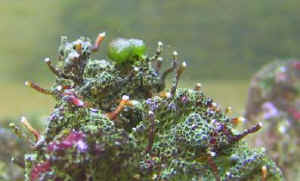
|
Re: hydroid 11/15/08 I've attached 2
pics of these hydroids (pulled out of the aquarium and
place them on paper). Is it possible to identify them now?
Are they some type of worm? <Mmm, much more likely tube
snails... though could be Sedentariate Polychaete worms...
You can tell if/when they're "open"
underwater> Will Prazi or some type of anthelminthic
work? Any suggestions besides nuking my system? Thanks once
more <Mmm, I'd ignore them... not deleterious... you
could likely get a crustacean that would predate these... I
would not use chemical controls.
http://www.reefs.org/library/aquarium_net/0897/0897_8.html
Bob Fenner>
re: hydroid... snails
11/15/08 Thanks for the link. However, the link
describes a mucus string/web produced by these worms but
there is no mention of sting. I've had mushrooms die
and retract if they are touched by these strands.
<Surprising...> Would these strands have some type of
sting? <Not as far as I've ever run into> The
link describes animals larger than the pics I sent. Animals
in my system have diameters of 1mm or less. So I take it
they are not hydroids? <Not hydrozoans, Cnidarians...
are Mollusks, Gastropods. B>
re: hydroid 11/15/08
I'm in complete agreement with you after further
surfing...just have to figure out why the mushroom died and
why any softy kinda retracts when the mucus strands are
out. Perhaps its something else I haven't noticed.
I'll be keeping a close eye. Thanks for all the help!
<Certainly welcome! BobF>
|
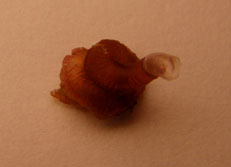 |
|
|
Critter Ids -- 10/09/08 Good Afternoon,
<Good morning.> I have just a few questions that I cant
seem to find an answer to. First all the pertinent info, the tank
is 90 gal with 2-250w 14k HQI bulbs and 4 65w actinic CF. with a
30 gal sump. The water parameters are as follows. Salinity-1.024,
Ammonia-0, Nitrate-0, Nitrite-0, Phosphate-0, Alk-8, Cal-480,
Temp 77 day 75 night. Okay here are the questions I recently
re-arranged some rock to provide better water circulation and I
found this weird spiky egg looking thing. It is approx.
2'' in a egg shape. Its kind of hard to see the little
spikes in the pic but they are there. <A sponge. See here:
http://www.wetwebmedia.com/spongeidfaq2.htm and the other
FAQs.> The other "thing" in question is this little
tube like worm growing on the side of my hammer coral. It appears
to be a pinkish tube with a black worm inside. It sends out a
long string of mucus which traps stuff then sucks it back in. I
read the other post on this but there were no pics. The pic that
I have is not the best as I would have to disassemble quite a bit
to get a great pic of it but if you look in between the two heads
you will see the little black creature with the two
"pincher's?" and the mucus trail. <A Vermetid
snail (worm snail, a sessile gastropod). Another harmless animal,
only in few cases with thousands of individuals they apparently
somewhat irritated corals with their mucus nets See
http://www.wetwebmedia.com/snailidfaq7.htm and do a WWM/Net
search on Vermetid.> Just curious if either of these little
creatures are anything to be worried about? <Absolutely
harmless. Enjoy them.> Thxs, Kris. <Welcome. Marco.>
<<Spot on, as usual Marco. RMF>>
|
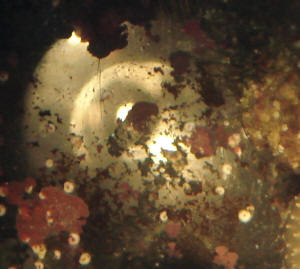 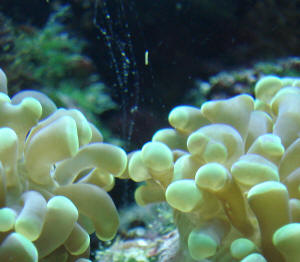 |
| Worm living in clam... Vermetid living on
Tridacnid 5/4/08 Hey guys, <Tom> First, i <... I>
just wanted to say i love this website. I use it to research
everything i see going on in my tank. It's always been
extremely helpful. Unfortunately, i couldn't find the answer to
this and am hoping someone can help. <I'll try> I just
purchased what i was told to be a Tridacna Clam a few hours ago.
<Is> When i got it home, about an hour after i placed the
clam in my tank, I noticed a worm coming out of the clam. <I
see... a Vermetid snail on the outside... end of the shell... is
this what you're referring to?> I read that there are worms
that can burrow it's way in, but the reason i thought this is a
different situation is that it looks as if the hole that it enters
is actually a hole that is part of the clam. It's as if
it's hole is a tunnel, and you can see it running down the
clam. In the picture, all you can see is the top of it's head
and antennae, everything below is actually part of the clam, not
the worm. Can someone help? Is this normal, is it a clam that
should quickly be quarantined and then returned to the LFS? Thank
you so much for your help!!! Tom. <Is a tubiculous snail... not
to worry... not destructive, deleterious... And even very
interesting... See the family name on the Net, WWM... Bob
Fenner> |
|
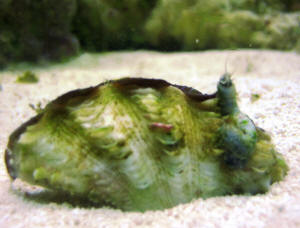
|
|
Worms!!! Help!!! 10/27/07 Hello, I'm
having a huge problem with a tube worm "tubiculous
Polychaete"? <That's actually not an animal name.
It's an adjective put before a descriptive noun. Basically,
it's just a fancy way of saying "tube worm."> It
started out as two that where in my tank for a couple years. They
were really cool at first, never multiplied or disturbed
anything, just cast a silk line out every now and then and would
reel in various things that floated by.? <They sound like
Vermetid snails. They're actually not worms. Please see here:
http://reefkeeping.com/issues/2005-01/rs/index.php> Suddenly,
after all this time, they have started multiplying exponentially.
I've literally got hundred of them and there silk is
bothering corals and making the tank look nasty. <They're
probably not bothering the corals, but they can be aesthetically
unpleasing.> To top it off, the tubes they make are sharp and
I've cut myself several times on them. Do these things have
any natural predators that I can put in the tank, or is there
some other way to get rid of them? <I don't think they
have any predators you could keep in an aquarium. But these
things usually go through booms and busts. They'll likely
start to die down eventually on their own. There are some
desperate measures you could take (involving things like NaOH),
but if I were you, I'd just make my peace with them for now
and hope they go away eventually.> Any help would be greatly
appreciated. Thank you for all the great info! Will <De nada,
Sara M.>
Re: was ID, now Vermetid snails hurting corals?
-- 10/28/07 Sara M., Thank you for helping me put an name to
my plague. After doing some research, I found some pics of
Vermetid snails and that is definitely what they are. I also
found a study on their effects on corals in the wild and it
stated that they can reduce growth of some corals by up to 90%
(http://eco.confex.com/eco/2007/techprogram/P7313.HTM). <Very
interesting! Thank you. However, the researchers only looked
small polyped stony corals. And even among those, they noted that
there was a great difference in how much the snails apparently
effected each of the different types of corals. I wouldn't
jump to the conclusion that these snails would have the same
effect on other corals. Also, I'm curious to know more about
the details of the research (i.e. did they study just one type of
Vermetid snail or all types?). There is a great variety of
Vermetid snails on reefs. For one thing, some are quite large
while some are really small. This study is certainly thought
provoking, and I thank you for finding and sharing it. However, I
wouldn't read too much into it at this point.> I found
another site that said that some Copperbanded butterflies will
eat them. Do these fish pose any threat to desirable corals??
<Butterfly fish aren't generally considered "reef
safe." There's no guarantee they would prefer the
Vermetid worms to your soft corals. Please see here:
http://www.wetwebmedia.com/BFsBestWrst.htm> Right now all I
have is Zoanthids, xenia, and mushrooms. <As mentioned, I
wouldn't assume that the study results apply to soft
corals.> Thanks again! Will <De nada, Sara M.>
|
|
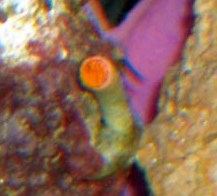
|
| What Is This...A Worm, Coral, Pest, Any Clue? --
10/06/07 This thing emits strings of mucous, which it
periodically releases into the current. It acts like a tubeworm and
when I touch it, it goes into its shell, and its orange head almost
penetrates the tip of that shell, but never more than about a
quarter-inch. I can see what look like hairs in there, but they
never extend. It sends out mucous when I feed the fish/corals brine
shrimp. Any clue what this is? <<Yes, not a worm, coral, or
pest but rather a type of mollusk'¦Is a Vermetid
Snail'¦a beneficial detritivore>> It just grew
there. <<Indeed>> I can't find it in any books.
Thanks! <<Try a keyword search of our site/the Net. Regards,
EricR>> |
| Small tubes over rocks... Small Tube Snails
(Petaloconchus spp) 7/11/07 <Greetings! Mich here.> Could
you guys tell me what those small tubes are. <Hopefully!>
They are coming out all over my live rock? They are hard, can't
see anything coming out and some are linked in a single cobweb
texture. <At first glance, I thought these were the calcareous
tubes produced by the Serpulidae family of feather dusters.
However, your description more closely fits Caribbean or small worm
snails (Petaloconchus spp) and closer visual inspection would also
indicate this to be the case.> I used to have some on bottom of
rocks but they have started to multiply rapidly. <Not
uncommon.> Thank you guys! <You're welcome from one of
the gals!> |
|
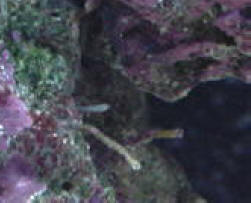
|
| Speaking of critters... -- 07/07/07
Check out these cool pics I took of one of my Vermetid snails.
It's the same one that's on the home page for my website.
Everyone always tells me I should have a picture of something
"pretty" on the home page. But honestly, how is this
thing not beautiful? <Ahh, very nice... daily pic.
B> |
|

|
| ID Help! Vermetid Snail - 7/20/07
Hey Crew! <Hello Eric! Mich here.> I need help trying to ID
something in my tank. <Certainly!> I'm really not sure
what it is, so I can't look it up. <Yep, been there done
that!> I found it on the crushed coral at the bottom of the
tank. It's a flat disc, about ¼' across, light
purple/white rings (somewhat like a tree's rings). It looks a
little like a Montipora Capricornis, but it's smooth, not the
right texture, and it seems to be growing from the middle out. It
was stuck to a few other chunks of crushed coral, and I knocked
them off. There was one piece left attached to it, and I set it up
on a rock to see what it did. This morning I looked at it, and it
moved. It has 'spider webs' back to where it WAS sitting on
the rock, and it has curled its one edge to hang on to the rock,
but still be horizontal to receive the most light exposure. It
seems to move like a starfish, with little feelers, maybe. From the
bottom I got a picture and it looks like a donut, the center is
thinner so you can see more light through it. I can't get a top
pic because it's so close to the front of the tank. Can anyone
ID this strange specimen? <Looks like a tube snail of the family
Vermetidae, aka Vermetid snail to me. The "spider webs"
they secrete into the water column are used for feeding. These are
harmless filter feeders. You can read more about them here:
http://www.reefkeeping.com/issues/2005-01/rs/index.php > Thanks
for any help, Eric Ziegler |
|
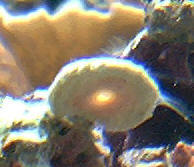
|
Worm-like growth ID sedentary snail (Petaloconchus spp.)
3/30/07 I have a hard worm-like structure growing out of my Pagoda
coral as well as one growing out of the base of my torch coral. The
thing seems to spew out this web-like substance that gets tangled
around my rocks and structures. Any idea what this is? <Yes, sounds
like a sedentary snail (Petaloconchus spp.)> Is it dangerous
<Nope!> and how can I get rid of it? <I wouldn't.>
Thanks. <Welcome! -Mich>
| What are these? Worm Snails / Vermetid Snails
3/7/07 Hello, <Hi Cindy, Mich here.> My husband and I
have inherited a 30-gallon salt water aquarium. <Welcome to the
briny world.> Being beginners, we are making our best effort to
do this right and your site has been very helpful. <Glad to hear
this. I would also recommend a book by Robert M. Fenner titled
"The Conscientious Marine Aquarist. It is an excellent book,
especially for a beginner, but belongs on the shelf of every
saltwater hobbyist, in my opinion.> We have these growths all
over the living rock and coral, they are circular and seem to have
a semi hard coating or shell. Some are very dark in color and
others are light brown, and some have a portion that grows out. I
have looked and searched and can't seem to find anything that
matches. Do you know what they are and will they do any harm ?
<Yes they are actually sessile snails, commonly called worm
snails or Vermetid snails. They are beneficial filter feeders, but
be careful, as their calcareous tubes can be quite sharp and cause
painful punctures or cuts when brushed up against.> Thank You
Very Much for Your Time, <You are very welcome, my pleasure to
serve. Mich> Cindy Boyd |
|
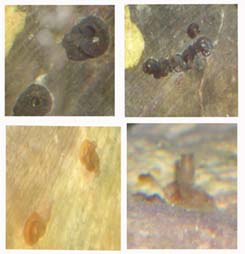
|
|
Critter Ids -- 10/09/08
Good Afternoon,
<Good morning.>
I have just a few questions that I cant seem to find an answer
to. First all the pertinent info, the tank is 90 gal with 2-250w
14k HQI bulbs and 4 65w actinic CF. with a 30 gal sump. The water
parameters are as follows. Salinity-1.024, Ammonia-0, Nitrate-0,
Nitrite-0, Phosphate-0, Alk-8, Cal-480, Temp 77 day 75 night.
Okay here are the questions I recently re-arranged some rock to
provide better water circulation and I found this weird spiky egg
looking thing. It is approx. 2'' in a egg shape. Its kind
of hard to see the little spikes in the pic but they are
there.
<A sponge. See here:
http://www.wetwebmedia.com/spongeidfaq2.htm and the other
FAQs.>
The other "thing" in question is this little tube like
worm growing on the side of my hammer coral. It appears to be a
pinkish tube with a black worm inside. It sends out a long string
of mucus which traps stuff then sucks it back in. I read the
other post on this but there were no pics. The pic that I have is
not the best as I would have to disassemble quite a bit to get a
great pic of it but if you look in between the two heads you will
see the little black creature with the two
"pincher's?" and the mucus trail.
<A Vermetid snail (worm snail, a sessile gastropod). Another
harmless animal, only in few cases with thousands of individuals
they apparently somewhat irritated corals with their mucus nets
See http://www.wetwebmedia.com/snailidfaq7.htm and do a WWM/Net
search on Vermetid.>
Just curious if either of these little creatures are anything to
be worried about?
<Absolutely harmless. Enjoy them.>
Thxs, Kris.
<Welcome. Marco.> <<Spot on, as usual Marco.
RMF>>
|
  |
|
|

